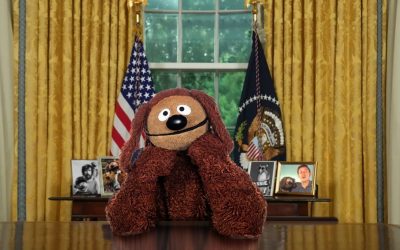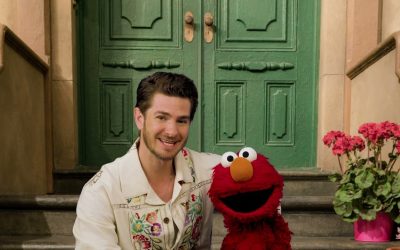Part 1 – Part 2 – Part 3 – Part 4
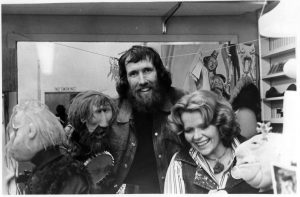 Bonnie Erickson is a Very Important Person in Muppet history. She started working with Jim Henson as a costume designer and puppet builder during the production of The Frog Prince, and later served as the head of the Muppet Workshop during the early days of The Muppet Show. Currently, she serves as the Executive Director of the Jim Henson Legacy. Also, she built the first incarnation of a character named Miss Piggy. Recently, she sat down with us for a Q&A about her long relationship with the Muppets, and in this first installment, she discusses early experiments in puppet-making, working with Don Sahlin, and the concept of a “Muppet look.”
Bonnie Erickson is a Very Important Person in Muppet history. She started working with Jim Henson as a costume designer and puppet builder during the production of The Frog Prince, and later served as the head of the Muppet Workshop during the early days of The Muppet Show. Currently, she serves as the Executive Director of the Jim Henson Legacy. Also, she built the first incarnation of a character named Miss Piggy. Recently, she sat down with us for a Q&A about her long relationship with the Muppets, and in this first installment, she discusses early experiments in puppet-making, working with Don Sahlin, and the concept of a “Muppet look.”
Tough Pigs: You were in costume design before puppet design… How did you get started with costume design?
Bonnie Erickson: When I first came to New York, I had a lot of different jobs, but I came from a background in theater and art. I went to the Art Students League, and while I was there working in the city, I was making clothes and hats and accessories for small boutiques. A costume designer saw them, called me, asked me if I would be interested in working on a project with her because she knew that I had a theater background. I said absolutely.
I was coming from a performing standpoint; I hadn’t really done a lot of costuming work. She hired me after I told her I’d had some experience, and she’d seen the work I’d done in the boutique, and I went in the first day, and sewed on the machine backwards. She came in and said, “You know you’re sewing backwards?” and I said, “Oh yeah, I always do that.” I was not going lose this job! I worked for this designer, whose name was Patricia Quinn Stuart, for seven years doing a lot of off-Broadway, Broadway and Lincoln Center projects, for which I would mainly do specialty items. I would do masks, and things like that, and then I did a lot of freelance work at the same time.
It was during that time that I had a friend who called me and said, “Jim Henson’s looking for a costume designer,” and I went, “Oh, sure, right!” I knew Jim from the Tonight Show, Today Show, all the sort of bizarre, abstract stuff he did that I thought was hilarious. I was an admirer and a fan. I didn’t really believe it, and so this second call came and said, “He really is looking for somebody,” so I did call. I went up with my portfolio, and he said to call the next day, and this is when I met with Jim and his producer Diana Birkenfield, and they said, “We’d like you to come in and work on Frog Prince.” So that was the very beginning of it, and I came in initially to do costuming.
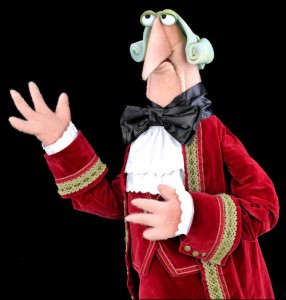 TP: Do you remember what the first thing was that you did for Frog Prince?
TP: Do you remember what the first thing was that you did for Frog Prince?
BE: I was costuming for Featherstone and the king. And I found out that not only was I hired to make the costumes, I was making bodies too. Jim had seen that I had a sculpting background, so I think that’s one of the reasons he gave me the job of costume designer for the puppets. They had just come back from doing The Santa Claus Switch, so it was Caroly Wilcox, John Lovelady, and Don Sahlin. Kermit Love was in and out – he was working part of the time. Faz Fazakas was in on a project-by-project basis.
When I was originally hired, it was as a freelancer, and I loved doing freelance work; that was the way I liked to work. The variety was incredible. I went in and did all the puppet costumes, and it was really a relief not to have to worry about a dancer’s inseam or their arm-stretch. I was working with puppets. But it had its own problems.
TP: What kind of adjustments did you have to make, making costumes for puppets versus people?
BE: I was lucky that Don Sahlin was a mentor for me at that point. When I first came in, Jim sat me at his table – I have to tell you a very funny story. I’ll wander and you can cut out what you think–
TP: We want you to wander!
BE: (Laughs.) I had been doing some experiments on soft foam, because that’s what they used underneath all of this fleece that they used. They had just finished the first year’s taping of Sesame Street, so they had all these fabrics and materials and they were just playing around with them. And there was this big mound of foam that had hairs sticking out of it, and it had feathers, and all kinds of stuff, and it was just this big thing sitting on the table.
I was sitting there, and I was sketching the designs for Frog Prince, and Don was there, sitting across from me, and he was sewing away… and I thought I saw this thing move. I looked at it, and it didn’t do anything, so I thought it must be my imagination. So I went back to drawing, and I could have sworn I saw it move again! I looked at Don, and he’s still sewing away, and I couldn’t figure out what was going on. Finally I saw it move and I reached over and grabbed it, and saw that Don had drilled a hole in the table and put an eyehook up inside the top of the head, with a string down through the table to a hook on the shelf of the table, and tied it to his shoe. He was sitting there and making this thing move and driving me crazy. And that was my introduction to Muppets.
I was thinking about this later and realizing, you know, so many people have been so loyal to Jim, and to the work, and people have hung in there for so long. And I realized that we do it because it made us happy. We were happy people working on those projects in those early days. It was a small crew, which grew, and I think when I finally left to start my own business we had gone from about seven people to about 27.
TP: And that was in the Muppet Show days?
BE: That was ’76. And then of course there was a large group of freelance people who would come in and work on special projects, because Jim was always interested in artists who were doing interesting things that he could adapt to what he was doing.
It was interesting because not everyone who worked at Muppets was a puppet person. I came in and I had never really done puppets, but I had been a sculptor and I had done costumes, so that was my intro. There were other people who had graphic backgrounds, like Michael Frith who came in later and was an illustrator. There were people who had simply been performers – Fran Brill, for instance, came in as an actor and had never done puppets before. Dave Goelz was an industrial designer and became a puppet builder and a primary puppeteer.
[Jim] made it really important to adapt all these skills and bring them in to inform the puppetry that he was doing. He didn’t start out as a puppeteer either. He did it because of his interest in the technology of television, and film as well, as you know from his films like Timepiece and all that. That’s sort of the direction he was headed until fame and fortune took him a different direction.
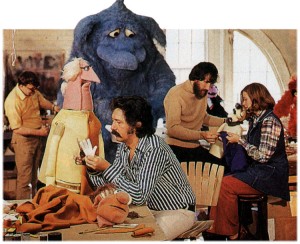 TP: I want to back up a quick second to Don Sahlin. You worked pretty closely with him?
TP: I want to back up a quick second to Don Sahlin. You worked pretty closely with him?
BE: I worked closely with him. I adored him. I think we all did.
TP: I don’t know if we know much about him. From what we’ve seen it seems like he was a very quiet, distinguished kind of guy. He didn’t try to take the spotlight very often.
BE: No, he didn’t. He was shy, but he was a beautiful, generous person. He was really so clever and so dedicated, and he was a purist in every way. He did work for Burr Tillstrom. He was a stop-motion animation specialist. If you look at the original Time Machine, one of the ways they describe what’s happening in terms of time passing is, they show this window with a clothing mannequin, and it changes as the period changes. That’s Don Sahlin, making those changes in the clothes.
He worked with Jim also on his stop-motion animation things that later became part of the pieces that he did for Sesame Street and the pieces that appeared on the variety shows. Don took a lot of those designs and really engineered them to be beautiful, movable objects.
One of the things I had to learn was how to design puppets, because I had never done that before. I could always do the shapes, and I understood the movement, and I certainly loved posing things, but to actually have to have something that moved, that fit on somebody’s hand, to be comfortable — Don was the one who really showed me how the mechanics could work.
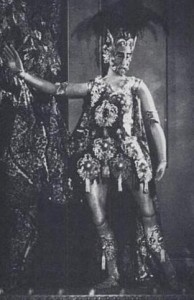 He was also a great cook. He would have dinners. And he was a fabulous marionettist. He had a marionette called Salome, and he used to invite us over for dinner, and then do this incredibly seductive dance with Salome. He was also a big opera fan, and his favorite composer was Rameau, the French composer. I’m not sure if people even realize, but he did a three- or four-foot tall marionette of Jupiter for one of the Rameau operas, and I think that marionette is now up at the University of Connecticut. It probably belongs to Don’s family, but they have it on loan there. I’m not sure if it’s on display now.
He was also a great cook. He would have dinners. And he was a fabulous marionettist. He had a marionette called Salome, and he used to invite us over for dinner, and then do this incredibly seductive dance with Salome. He was also a big opera fan, and his favorite composer was Rameau, the French composer. I’m not sure if people even realize, but he did a three- or four-foot tall marionette of Jupiter for one of the Rameau operas, and I think that marionette is now up at the University of Connecticut. It probably belongs to Don’s family, but they have it on loan there. I’m not sure if it’s on display now.
Donald was an excellent carver. He could work with foam, he could sew, he was just so multi-talented, and he could take any drawing, the roughest sketch — those sketches Jim did of Bert and Ernie. Give them to Don, and he’d transform them into these most incredible devices for the personalities that Jim wanted to perform. And the combination of Jim, Frank, and Don was the perfect triumvirate for those beginning years.
TP: Do you feel like there’s a philosophy, or a “Muppet style,” as far as what makes a Muppet a Muppet, that’s been passed on since then to the current group?
BE: I think there are a lot of elements in that, but you know, nothing has stayed the same. For instance, when I came in, everything was done with a soft foam innard, and then it was covered with fabric. Well, we ran out of the fabric, so then Jim and I started playing around with carving the foam. Before that, everything had to be covered, but once Jim actually discovered flocking — which was also another funny story — he took us out to see a guy who had come up with a way to do flocking by hand.
They’d been doing flocking as manufacturing for a long time. When you saw jewelry cases that looked like velvet but weren’t, that was flocking, but it usually meant big belts of material going through and being flocked electrostatically. This guy had figured out a way to do it with a hand shaker. Jim took us all to his studio, which was built over a stream, because that would help the electric charge. We were all fascinated with this. For about three weeks we flocked everything in sight. Eventually we realized that we had to have special things, to wear glasses, things like that. But we were so enamored of this whole process.
That’s when we realized that we could [avoid] one of the problems with the soft puppets, the soft foam heads – if you cast them, you automatically had a skin on it, and it wrinkled. If you wanted to have somebody make an expression, if you did it in the latex it would make ugly wrinkles. It didn’t soak up the motion. But if you carved it, then those little pores stayed open, and they would expand and contract with the motion and give an expression without making those wrinkles. Because of the flexibility with the glue we were using, we could color it, and we could match it with a flock that was very short, very fine denier, so that it almost looked like real skin, and it didn’t inhibit the movement at all.
So it was like the perfect combination, but all of that came from a lot of experimentation, and a lot of new materials that were constantly being adapted.
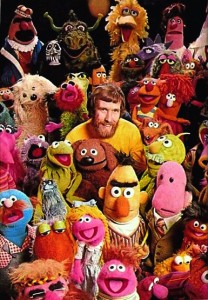
So when you say, “Is there a Muppet look?” there are many Muppet looks. Any time something came up as a new material, we tried very hard to refine it as much as we possibly could, to make it look as seamless as we possibly could, and make it adaptable to a performer, because that, of course, is the whole point. For a long time I used to heat up a tube and push it through the foam, because it created a nice sort of stickiness, actually, for puppeteers to put the fingers in… and then we realized how toxic some of these things were! So, artists beware! Really get to know your materials before you use them.
There’s a Muppet stitch, which of course is the stitch that’s been around for a long time, but Jim used it to such great effect, and I’m sure that that was in part some of Don’s contribution because he came with that kind of a background. When we first started, I called what my own company, Harrison/Erickson, was doing “soft engineering.” It was using soft materials to try to make them work, be strong, and last.
When they learned finally to use foam and cast it for the movies and things like that, it worked very nicely, it looks beautiful, but it doesn’t last long. You have to have several versions because it’s very delicate. So we were trying for not-too-deliciate… Miss Piggy lasted the whole first year of The Muppet Show before they had to redo her, and I think we still may have the original head in some shape or form in the collection. So the look was something that developed and evolved.
Then of course the look became totally different with Dark Crystal and Labyrinth, but that was an extension of what we did with Saturday Night Live, when Jim first decided we were going to use taxidermy eyes. We were all going, “What?! No buttons? No ping-pong balls?” But then that became a Henson look, so really it was constantly moving, which is really the way things should stay alive and up to date.
TP: A puppet from something like The Jim Henson Hour is completely different from one from the early productions.
BE: Right. And now, when you look at CGI – they’re using CGI, but in a very different way, so that becomes a whole other area, which the company is exploring now.
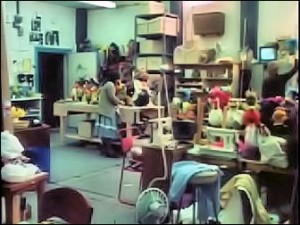 TP: You were the head of the Muppet Workshop for a while. In addition to being able to experiment with these things, and actually physically building the puppets, what were your responsibilities with that position?
TP: You were the head of the Muppet Workshop for a while. In addition to being able to experiment with these things, and actually physically building the puppets, what were your responsibilities with that position?
BE: For a lot of things when we were doing productions, it was overseeing packing in, packing out… It was still close enough that Jim was often in the workshop. In fact, we worked together on the Swedish Chef. He would come in and work with everybody who was doing projects and be involved, giving his opinion, checking in, but as things got busier, certainly after Muppet Show when part of the group was in London and part of it in New York, that changed.
I would say, as far as overseeing things, my job was to make everybody comfortable. I had a great group of people to work with. It was an amazing time. I don’t think anybody ever made a puppet without going to somebody else and saying, “What do you think about…?” It was a group effort.
There were a lot of theater people there. We had Mari Kaestle, who had come in and was doing things like the Seven Deadly Sins, and everybody was sort of bringing their own style, because Jim at that time would do quick sketches – just an idea of what he wanted, and there was a lot of leeway for the artists who worked in the shop to create something of their own or to add to it, with Jim coming in and giving feedback on what was happening.
I came back later, and worked on Fraggle Rock, and at that time we had an enormous amount of sculptors and costumers and everything else working on that project, and that was a little more specific, because by that time Michael Frith had done drawings which were more detailed. I think in some ways, a lot of us enjoyed the freedom that Jim’s sketches had, in terms of just giving us an idea of what the personality was. Later, when they were much busier, they had to be refined a little more, so that was not always so possible.
So I was responsible for making sure that we met deadlines, I was responsible for overseeing shopping and what was being brought in for all the different projects, making sure the colors were working, making sure we were communicating with writers. The whole process was an ensemble group.
Our thanks to Bonnie Erickson for her time, insight, and memories! Stay tuned for part two! And click here to flock everything in sight on the Tough Pigs forum!
by Ryan Roe – Ryan@ToughPigs.com

